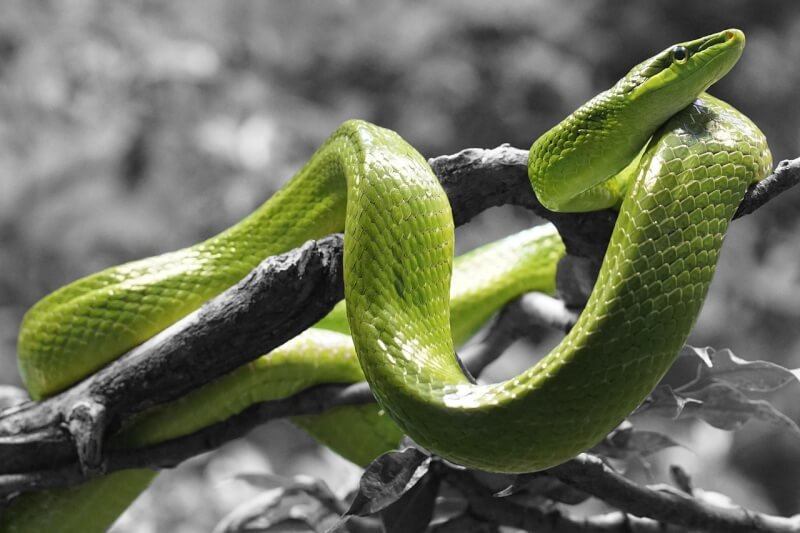Did you know that not all snakes are venomous? While snakes are often associated with venom, it is a common misconception that all snakes are equipped with toxic bites. In fact, there are numerous snake species that are completely harmless to humans. So, if you’ve ever wondered whether every snake is venomous or not, this article will provide you with a clearer understanding of the fascinating world of snakes and their venomous capabilities. Prepare to be surprised by the diversity and complexity of these remarkable creatures!
Types of Snakes
Snakes are fascinating creatures that can be found in various parts of the world. There are thousands of different snake species, each with its own unique characteristics and behaviors. In order to better understand these incredible creatures, it is helpful to categorize them into two main groups: venomous snakes and non-venomous snakes.
Venomous Snakes
Venomous snakes are a group of snakes that possess venom glands, which produce and inject venom into their prey or potential threats. Venom is a specialized secretion that can cause a range of reactions in the body of the recipient. While venomous snakes are often portrayed as dangerous and deadly, it is important to remember that they are a vital part of our ecosystem and play an important role in controlling populations of rodents and other pests.
Non-venomous Snakes
On the other hand, non-venomous snakes do not possess venom glands and rely on other methods to capture and subdue their prey. These snakes are not equipped with the ability to inject venom, making them generally harmless to humans. Despite their lack of venom, non-venomous snakes can still be a source of fear for some individuals who may have a phobia or general aversion to snakes. It is crucial to understand the differences between venomous and non-venomous snakes in order to dispel any misconceptions and promote better coexistence with these creatures.
Venomous Snakes and Their Characteristics
Introduction to Venomous Snakes
Venomous snakes have fascinated humans for centuries. Their venomous nature has earned them a reputation for being dangerous and feared by many. However, it is important to note that not all venomous snakes are equally harmful and aggressive towards humans. There are various types of venomous snakes, each with its own unique characteristics and venom composition.
Types of Venomous Snakes
There are numerous species of venomous snakes found worldwide. Some of the well-known venomous snake families include the Viperidae (vipers), Elapidae (cobras, mambas, and coral snakes), and Crotalidae (pit vipers). These families encompass a wide variety of species, each with its own specific traits and habitats.
Venomous Snakes and Their Venom
Venomous snakes owe their ability to immobilize their prey to their venom. The venom is a complex mixture of proteins, enzymes, and other substances that vary from species to species. Some venomous snakes have neurotoxic venom that affects the nervous system, while others have hemotoxic venom that targets the blood and tissues. Understanding the different types of venom found in venomous snakes is crucial when it comes to diagnosing and treating snakebites.
Symptoms of Venomous Snakebites
When it comes to venomous snakebites, the symptoms can vary depending on the snake species and the amount of venom injected. Common symptoms include localized pain, swelling, redness, and bleeding. Additionally, more severe symptoms can occur such as difficulty breathing, blurred vision, numbness, and paralysis. It is important to note that not all snakebites result in venom injection, as some snakes may deliver “dry bites” without releasing venom.
Treatment for Venomous Snakebites
If someone is bitten by a venomous snake, it is crucial to seek immediate medical attention. Time is of the essence when dealing with snakebites, as the effects of venom can escalate rapidly. While waiting for medical professionals to arrive, it is important to keep the affected limb immobilized and positioned at or below heart level. Applying a clean, firm bandage above the bite area, but not too tight, can help slow down the venom spread. It is essential to avoid any DIY remedies, such as tourniquets or cutting the wound, as these can cause more harm than good.
Non-venomous Snakes and Their Characteristics
Introduction to Non-venomous Snakes
Non-venomous snakes make up the majority of snake species. These fascinating creatures play crucial roles in balancing ecosystems and controlling populations of rodents and other pests. While they lack venom, non-venomous snakes possess other intriguing characteristics that make them unique and worthy of admiration.
Common Non-venomous Snakes
There are numerous species of non-venomous snakes found in various parts of the world. Some well-known examples include the corn snake, garter snake, rat snake, and king snake. These snakes are often appreciated for their beautiful patterns, non-aggressive behavior, and their ability to adapt to various habitats. Non-venomous snakes are often sought after by reptile enthusiasts as pets due to their generally docile nature.
Distinguishing Venomous and Non-venomous Snakes
Differentiating between venomous and non-venomous snakes can be a crucial skill, especially for those living in areas where venomous snakes are common. There are several visual and behavioral cues that can help in this identification process. Venomous snakes often possess triangular-shaped heads, vertical eye pupils, and large, hollow fangs for venom delivery. Non-venomous snakes, on the other hand, usually have smaller heads, rounded pupils, and lack specialized venom delivery apparatus.
Dangers and Precautions
Understanding the Potential Dangers
While venomous snakes can pose a risk to humans, it is important to understand that snakebite incidents are relatively rare. Snakes are generally shy creatures that prefer to avoid human interaction. Most snakebites occur when humans unintentionally provoke or disturb a snake, such as stepping on one or trying to handle a snake without proper knowledge and precautions. By understanding the potential dangers and respecting snakes’ habitats and behaviors, the risks associated with snake encounters can be minimized.
Preventing Snakebites
Prevention is the key when it comes to avoiding snakebites. Being aware of your surroundings, especially in snake-prone areas, is crucial. Wearing appropriate footwear, such as sturdy boots, can provide added protection against snakebites. It is also advisable to avoid placing your hands or feet into areas where you cannot see, such as rock crevices or tall grass. Additionally, keeping your living spaces clutter-free and regularly inspecting your surroundings can help reduce the likelihood of snakes entering your property.
What to Do If Bitten by a Snake
In the unfortunate event of a snakebite, it is important to remain calm and seek medical help as soon as possible. While waiting for medical professionals, it is crucial to keep the affected person calm and still, as movement can expedite venom circulation. If possible, try to identify the snake or take a picture of it for identification purposes. However, it is important not to waste valuable time and put yourself or others at risk by attempting to capture or kill the snake.

Myths about Venomous Snakes
Identifying Myths and Misconceptions
Venomous snakes have been the subject of numerous myths and misconceptions throughout history. These misconceptions often lead to unnecessary fear and harm towards snakes. By debunking these myths and spreading accurate information, we can foster a better understanding and appreciation of venomous snakes.
Dispelling Common Myths
One common myth about venomous snakes is that they are always aggressive and ready to attack. In reality, venomous snakes would rather avoid confrontation and will usually only bite if they feel threatened or cornered. Another myth is that all venomous snakes are deadly and their venom is instantly lethal. While some venomous snakes do possess potent venom, the majority of snakebite incidents are not fatal with proper medical treatment.
Educating the Public
Educating the public about venomous snakes is essential in dispelling myths and promoting coexistence. By providing accurate information about their behavior, habitats, and the appropriate actions to take when encountering a snake, we can reduce unnecessary fear and improve snake-human interactions. Organizations, nature centers, and educational programs play a vital role in spreading this knowledge and fostering a healthy relationship between humans and snakes.
In conclusion, snakes are a diverse and fascinating group of creatures. Categorizing them into venomous and non-venomous snakes helps us better understand their characteristics, behaviors, and the precautions necessary for safe interactions with them. By dispelling myths and educating the public about these incredible creatures, we can foster a greater appreciation for their role in our ecosystems and promote peaceful coexistence with snakes. Remember, knowledge and understanding are the keys to respecting and appreciating these magnificent creatures.


